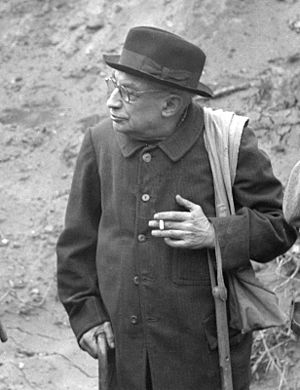Henri Breuil facts for kids
Quick facts for kids
Henri Breuil
|
|
|---|---|
| Abbé Breuil | |

Henri Breuil in 1954
|
|
| Born | 28 February 1877 |
| Died | 14 August 1961 (aged 84) L'Isle-Adam, Val-d'Oise, France
|
| Alma mater | Sorbonne |
| Awards | Daniel Giraud Elliot Medal (1924) Albrecht-Penck-Medaille (1958) |
| Scientific career | |
| Fields | |
Henri Édouard Prosper Breuil (born February 28, 1877 – died August 14, 1961), often called Abbé Breuil, was a French Catholic priest and a very important scientist. He studied many fields, including archaeology (the study of old human history), anthropology (the study of human societies and cultures), and geology (the study of Earth's rocks and soil). He is best known for his amazing work studying ancient cave art. He explored caves in France, Spain, Portugal, Italy, and even in China and Southern Africa.
Contents
Early Life and Education
Henri Breuil was born in Mortain, Manche, France. His father was a judge.
He went to school at the Seminary of St. Sulpice and the Sorbonne. He became a priest in 1900. Even though he was a priest, he was allowed to continue his scientific research. He was a very religious and smart man. In 1904, Breuil figured out that two carvings of reindeer at the British Museum, which were thought to be separate, were actually parts of one single artwork. This artwork is now known as the "Swimming Reindeer". In 1905, he started teaching at the University of Fribourg. Later, in 1910, he became a professor in Paris, teaching about prehistoric cultures.
Discovering Ancient Cave Art
Breuil was a very skilled artist himself. He carefully copied the cave paintings he found, making sure every detail was correct. His drawings helped people all over the world see these ancient artworks. In 1924, he won the Daniel Giraud Elliot Medal for his important work.
He wrote many books about his discoveries. He helped introduce famous caves like Lascaux and Altamira to everyone. In 1938, he became a member of the Institut de France, a very respected group of French scholars.
Exploring Beyond Europe
In 1931, Breuil visited the "Peking Man" excavation site in Zhoukoudian, China. He confirmed that ancient stone tools were found there, which was a big discovery.
In 1929, he went to a meeting about prehistory in South Africa. The prime minister, Jan Smuts, invited him back. Breuil returned to South Africa in 1942 and taught at Witwatersrand University until 1951. During this time, he studied rock art in places like Lesotho and the Drakensberg mountains. He also went on three trips to South West Africa (now Namibia) and Rhodesia (now Zimbabwe) between 1947 and 1950. He called this time "the most thrilling years of my research life."
The White Lady of Brandberg
In 1953, Breuil announced he had found a painting that was about 6,000 years old. This painting was under a rock in the Brandberg Mountain in Namibia and was later called The White Lady.
When Breuil studied the paintings in Southern Africa, he had some ideas about who created them that are not widely accepted today. For example, he thought "The White Lady" might have been painted by people from the Mediterranean, like Egyptians. However, most scientists now believe these paintings were made by the local Bushmen and other native people of Namibia and South Africa, and they show their own way of life.
Breuil returned to France in 1952. He continued to publish many books about his findings. His work greatly helped us understand ancient art in Europe and Africa. He received special awards and honorary degrees from six different universities. He was also the President of the PanAfrican Archaeological Association from 1947 to 1955.
Henri Breuil passed away in L'Isle-Adam, Val-d'Oise, France.
Published Works
Some of his books in English include:
- Rock Paintings of Southern Andalusia (1928)
- The Cave of Altamira at Santillana del Mar, Spain (1935)
- Four Hundred Centuries of Cave Art (1952)
- The White Lady of the Brandberg (1955)
- The Men of the Old Stone Age (1965)
See also
 In Spanish: Henri Breuil para niños
In Spanish: Henri Breuil para niños
- Cave painting
- Caves of Gargas
- Cave of the Trois Frères
- Cueva de La Pasiega
- Cave of Altamira
- Pierre Teilhard de Chardin
- List of Roman Catholic cleric–scientists
- Les Combarelles
- Émile Cartailhac
Images for kids





